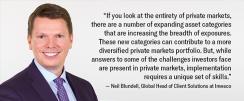In the mid-1990s, more than 8,000 companies were publicly traded on U.S. exchanges. By 2016, that number dropped to less than half that amount, where it remains today1. Since 2010, private market firms have recorded eight consecutive years of growth in assets under management, reaching $5 trillion globally in 2017.
The growth of private markets is due, in part, to shrinking public markets, but the boom is primarily due to the challenges institutional investors face around income, growth, and diversification. Low correlation to public markets has emerged as an added benefit of private markets in pursuit of all three of these goals.
“If you look at the entirety of private markets, there are a number of expanding asset categories that are increasing the breadth of exposures. These new categories can contribute to a more diversified private markets portfolio,” says Neil Blundell, Global Head of Client Solutions at Invesco. “But, while answers to some of the challenges investors face are present in private markets, implementation requires a unique set of skills.”

While private markets investments can be very attractive on an uncorrelated, risk-adjusted return basis, they also add a layer of complexity to the investment process, and it is critical to ensure that the risks and liquidity considerations, as well as the typically higher investment fees, are justified by what the strategy potentially brings to a portfolio.
“It’s important to grasp the dynamics of private markets,” says Blundell. “Understanding the assets that you are purchasing should include a holistic assessment of risk. What are the fundamental drivers of risk and return? When can you expect capital to be returned? What can go well? What can go poorly? How does liquidity align with the ability to match your liabilities? Numerous considerations have to be modeled to be fully understood. You also need to understand how private markets investments will interact with your broader portfolio. This encompasses how to fund the exposure from existing holdings and extends to how that changes your risk and return profile.”
These challenges are among the many that Blundell and the solutions-oriented team at Invesco train their factor lens on. “If you don’t break these potential enhancements down to a factor level, hidden risks may be stacking up in your portfolio.”
Optimizing solutions
Liabilities and funded status are typically a driving force in allocation strategy for institutions. Allocations to private markets can help investors achieve both income and growth goals, but some institutions can face a hurdle when a substantial minimum allocation is required. Co-mingled allocation vehicles into a diversified income or growth portfolio are one potential solution.
According to Duy Nguyen, CIO and Head of Global Advisory Solutions at Invesco, private market solutions for income and growth are built around investor “inputs” that, in and of themselves, help to form strategies. A few examples of inputs are the income level an investor needs, or the volatility level they are willing to accept, or the cash flow stream they want to match.
“If you need more growth you might tilt toward strategies such as private equity, infrastructure equity, and value-add and opportunistic real estate. They have a longer duration compared to most performing private debt strategies, but you’re compensated for the liquidity risk via a return enhancement,” says Nguyen.
On the income side, says Nguyen, investors might lean more toward debt instruments, such as middle-market lending, infrastructure debt, or real estate mezzanine debt. “If you have longer-term liabilities, you could consider a highly customized program with longer-term instruments that can serve return objectives or provide cash flows on a very steady basis.”
Achieving the optimal allocation strategy for private markets can put a strain on the operational team at some institutions. This is where Invesco can be an invaluable partner. In some cases, Blundell and his teammates may serve as a second set of eyes, perhaps leveraging Invesco’s capital market assumptions and leading-edge analytics to help refine the institution’s strategy in the private market space.
“It’s not uncommon for investors to come to us and say, ‘Can you help construct an optimal private markets completion portfolio?’” says Blundell. “We’ve done a lot of research on optimizing portfolios that include private markets, and how exposures integrate into a broader strategic asset allocation. In other scenarios investors might be less familiar with private markets than they’d like to be, but are keenly aware they aren’t getting the performance they need from traditional markets. Whatever the challenge, we aim to share to knowledge and analytical tools to collectively find the right answers alongside our clients.
The second installment of this story, on risk modeling in private market investing, will appear on institutionalinvestor.com the week of January 14.
Start the conversation to better outcomes. Learn more. (https://www.invesco.com/portal/site/us/institutions/global-solutions/)
1 “World Development Indicators.” World Bank. Dec. 18.
Disclosures:
All content provided by Invesco is for informational purposes only and is not an offer to buy or sell any financial instruments.
The opinions expressed are those of the authors, are based on current market conditions and are subject to change without notice. These opinions may differ from those of other Invesco investment professionals.
Invesco Advisers Inc. is an investment adviser; it provides investment advisory services to individual and institutional clients and does not sell securities.
Asset allocation, diversification and low or negative correlation do not guarantee a profit or eliminate the risk of loss.
Factor investing is an investment strategy in which securities are chosen based on certain characteristics and attributes.
Alternative products typically hold non-traditional investments and may employ complex trading strategies. Investors considering alternatives should be aware of their unique characteristics and additional risks from the strategies they use.






